The Ransomware Detected is a misleading advertising that has been created to force you into calling to fake Microsoft Support. If your favorite web browser opens automatically to “Ransomware Detected” fake alert then it is a sign that your system has become the victim of malware from the group of ‘ad-supported’ software (also known as adware).
If you get an adware on your PC system, it can change the web browser’s settings like home page, newtab page and default search provider and install malicious add-on which will open a large amount of intrusive and malicious pop ups such as “Ransomware Detected” pop-up alert within the Firefox, Google Chrome, Microsoft Internet Explorer and Microsoft Edge screen.
Quick Links
It’s important, don’t click on the misleading “Ransomware Detected” ads, as they can lead you to more malicious or misleading web pages. The best option is to use the steps posted below to clean your personal computer of ad supported software and thereby remove “Ransomware Detected” pop-up scam.
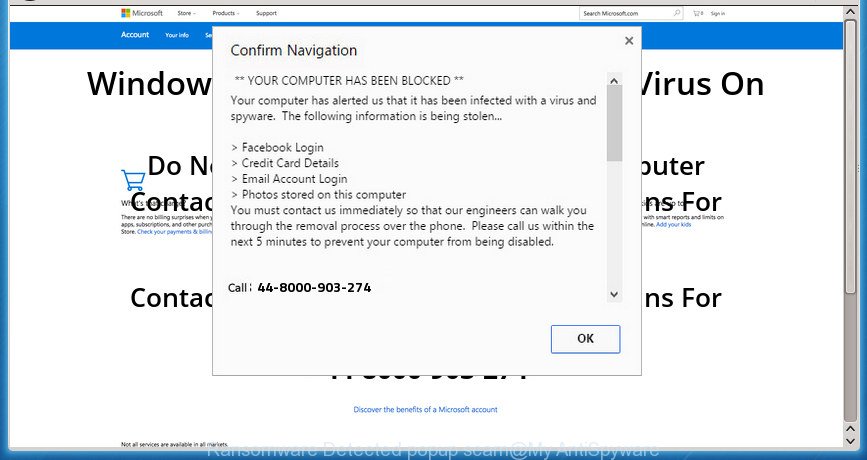
“Ransomware Detected” is a fake alert
The adware, that shows misleading “Ransomware Detected” ads, is not a virus, but the virus behaves similarly. As a rootkit hides in the system, modifies web browser settings and blocks them from changing. Also the adware can inject advertising links within the Chrome, FF, Internet Explorer and MS Edge’s screen. Moreover, the adware may install web-browser hijacker that once started, will alter the browser’s startpage and search engine. And finally, the ad-supported software can collect a wide variety of personal information such as what web sites you are opening, what you are looking for the Internet and so on. This information, in the future, may be transferred to third parties.
The ad supported software can change the settings of the Google Chrome, Firefox, Internet Explorer and Microsoft Edge, but often that a malicious software such as this can also infect all types of internet browsers by changing their desktop shortcuts. Thus forcing the user each time start the web browser to see the unwanted “Ransomware Detected” page.
Instructions which is shown below, will help you to clean your computer from the adware as well as delete “Ransomware Detected” annoying ads from the FF, Chrome, Internet Explorer and Microsoft Edge and other internet browsers.
Remove “Ransomware Detected” pop-up alert
Fortunately, it is not hard to delete ad supported software that causes multiple misleading “Ransomware Detected” alerts and popups. In the following tutorial, we will provide two solutions to clean your system of this adware. One is the manual removal method and the other is automatic removal way. You can choose the method that best fits you. Please follow the removal tutorial below to get rid of “Ransomware Detected” popup scam right now!
Manual “Ransomware Detected” popup removal
The steps will help you remove “Ransomware Detected” pop up alert. These “Ransomware Detected” removal steps work for the Chrome, Mozilla Firefox, Microsoft Edge and Internet Explorer, as well as every version of Windows operating system.
Remove PUPs through the Windows Control Panel
It is of primary importance to first identify and remove all PUPs, ad supported software applications and hijackers through ‘Add/Remove Programs’ (Windows XP) or ‘Uninstall a program’ (Windows 10, 8, 7) section of your MS Windows Control Panel.
Windows 8, 8.1, 10
First, click Windows button

After the ‘Control Panel’ opens, click the ‘Uninstall a program’ link under Programs category like below.

You will see the ‘Uninstall a program’ panel as shown below.

Very carefully look around the entire list of programs installed on your PC. Most likely, one or more of them are responsible for the appearance of popup ads and browser redirect to the intrusive “Ransomware Detected” web-site. If you have many programs installed, you can help simplify the search of malicious applications by sort the list by date of installation. Once you have found a suspicious, unwanted or unused application, right click to it, after that click ‘Uninstall’.
Windows XP, Vista, 7
First, press ‘Start’ button and select ‘Control Panel’ at right panel as on the image below.

After the Windows ‘Control Panel’ opens, you need to click ‘Uninstall a program’ under ‘Programs’ as shown in the figure below.

You will see a list of applications installed on your PC system. We recommend to sort the list by date of installation to quickly find the applications that were installed last. Most likely they responsibility for the appearance of advertisements and internet browser redirect. If you are in doubt, you can always check the program by doing a search for her name in Google, Yahoo or Bing. When the application which you need to delete is found, simply click on its name, and then click ‘Uninstall’ like below.

Get rid of unwanted Scheduled Tasks
Once installed, the ad-supported software can add a task in to the Windows Task Scheduler Library. Due to this, every time when you run your computer, it will open “Ransomware Detected” intrusive site. So, you need to check the Task Scheduler Library and delete all harmful tasks which have been created by malicious program.
Press Windows and R keys on the keyboard together. This opens a dialog box that titled as Run. In the text field, type “taskschd.msc” (without the quotes) and click OK. Task Scheduler window opens. In the left-hand side, press “Task Scheduler Library”, as shown in the following example.
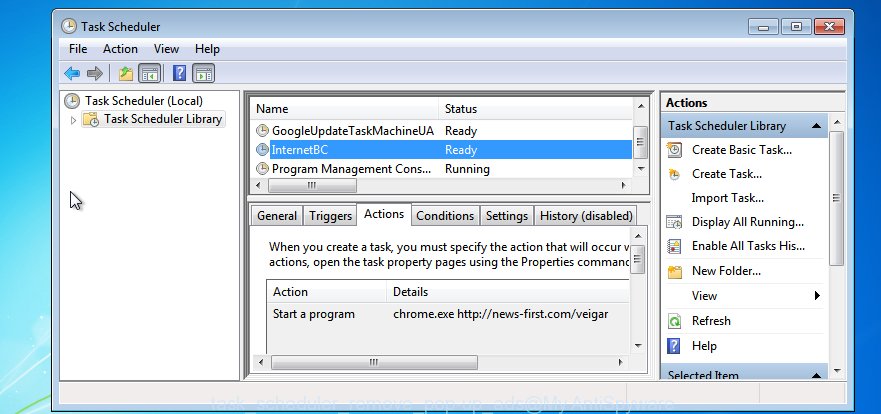
Task scheduler
In the middle part you will see a list of installed tasks. Please select the first task, its properties will be display just below automatically. Next, press the Actions tab. Pay attention to that it launches on your system. Found something like “explorer.exe http://site.address” or “chrome.exe http://site.address”, then delete this malicious task. If you are not sure that executes the task, check it through a search engine. If it is a component of the adware, then this task also should be removed.
Having defined the task that you want to remove, then click on it with the right mouse button and select Delete as displayed on the screen below.

Delete a task
Repeat this step, if you have found a few tasks which have been created by malicious programs. Once is done, close the Task Scheduler window.
Fix infected web-browsers shortcuts to remove “Ransomware Detected” redirect
Unfortunately, the adware can also hijack Windows shortcuts (mostly, your web browsers shortcuts), so that the “Ransomware Detected” ad web page will be displayed when you launch the Google Chrome, Microsoft Internet Explorer, FF and Microsoft Edge or another web browser.
Click the right mouse button to a desktop shortcut that you use to launch your browser. Next, select the “Properties” option. Important: necessary to click on the desktop shortcut for the web browser which is re-directed to the “Ransomware Detected” or other annoying web site.
Further, necessary to look at the text that is written in the “Target” field. The ad-supported software can replace the contents of this field, which describes the file to be launch when you start your internet browser. Depending on the web-browser you are using, there should be:
- Google Chrome: chrome.exe
- Opera: opera.exe
- Firefox: firefox.exe
- Internet Explorer: iexplore.exe
If you are seeing an unknown text like “http://site.addres” which has been added here, then you should remove it, as shown in the following example.

Next, click the “OK” button to save the changes. Now, when you open the browser from this desktop shortcut, it does not occur automatically redirect on the “Ransomware Detected” web-site or any other annoying web pages. Once the step is finished, we recommend to go to the next step.
Remove “Ransomware Detected” pop up alert from Chrome
Use the Reset internet browser utility of the Chrome to reset all its settings like start page, newtab page and search engine by default to original defaults. This is a very useful tool to use, in the case of browser redirects to annoying ad web sites like “Ransomware Detected”.
Open the Google Chrome menu by clicking on the button in the form of three horizontal stripes (![]() ). It will show the drop-down menu. Next, click to “Settings” option.
). It will show the drop-down menu. Next, click to “Settings” option.

Scroll down to the bottom of the page and click on the “Show advanced settings” link. Now scroll down until the Reset settings section is visible, as displayed on the image below and press the “Reset settings” button.
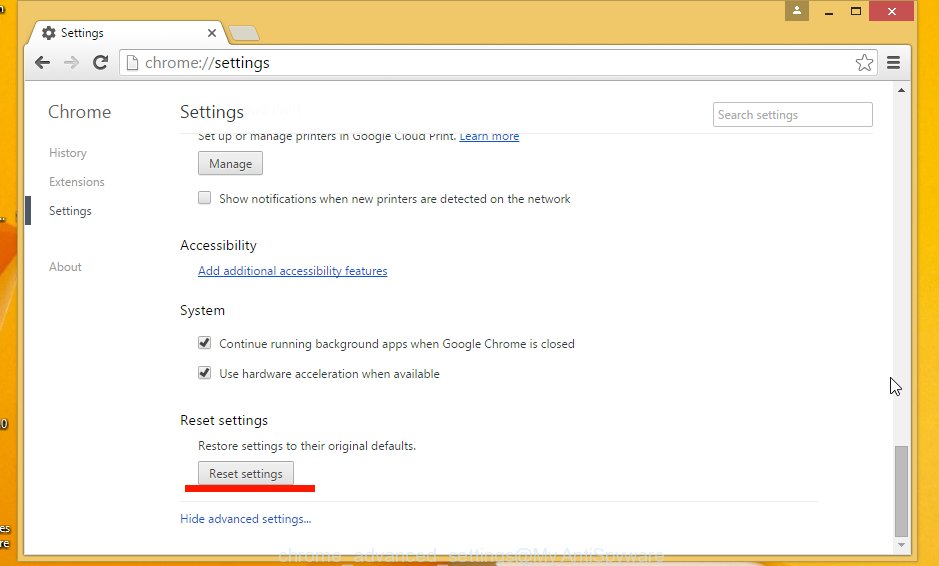
Confirm your action, click the “Reset” button.
Remove “Ransomware Detected” pop-up alert from Internet Explorer
By resetting Internet Explorer internet browser you return your browser settings to its default state. This is first when troubleshooting problems that might have been caused by adware that causes web-browsers to display misleading “Ransomware Detected” pop up scam.
First, launch the Microsoft Internet Explorer, click ![]() ) button. Next, click “Internet Options” as shown below.
) button. Next, click “Internet Options” as shown below.

In the “Internet Options” screen select the Advanced tab. Next, click Reset button. The IE will show the Reset Internet Explorer settings prompt. Select the “Delete personal settings” check box and click Reset button.

You will now need to restart your system for the changes to take effect. It will remove ad-supported software that created to display misleading “Ransomware Detected” popup scam within your internet browser, disable malicious and ad-supported web browser’s extensions and restore the IE’s settings like startpage, newtab page and search provider by default to default state.
Get rid of “Ransomware Detected” popup alert from Mozilla Firefox
If the Firefox settings such as startpage, new tab page and search provider by default have been replaced by the ‘ad supported’ software, then resetting it to the default state can help.
First, start the Firefox. Next, press the button in the form of three horizontal stripes (![]() ). It will display the drop-down menu. Next, press the Help button (
). It will display the drop-down menu. Next, press the Help button (![]() ).
).

In the Help menu click the “Troubleshooting Information”. In the upper-right corner of the “Troubleshooting Information” page click on “Refresh Firefox” button as shown in the following example.

Confirm your action, click the “Refresh Firefox”.
Scan your system and delete “Ransomware Detected” pop up scam with free utilities
Manual removal tutorial does not always allow to completely delete the ad supported software, as it’s not easy to identify and remove components of ad-supported software and all malicious files from hard disk. Therefore, it is recommended that you use malware removal utility to completely remove “Ransomware Detected” off your web-browser. Several free malicious software removal tools are currently available that may be used against the ad supported software. The optimum method would be to use Zemana Anti-malware, Malwarebytes Free and AdwCleaner.
How to delete “Ransomware Detected” popup alert with Zemana Anti-malware
Zemana Anti-malware is a tool which can remove ad-supported software, potentially unwanted applications, hijacker infections and other malware from your computer easily and for free. Zemana Anti-malware is compatible with most antivirus software. It works under Windows (10 – XP, 32 and 64 bit) and uses minimum of computer resources.
Download Zemana Free from the following link. Save it on your Windows desktop or in any other place.
164790 downloads
Author: Zemana Ltd
Category: Security tools
Update: July 16, 2019
When downloading is finished, close all programs and windows on your PC. Open a directory in which you saved it. Double-click on the icon that’s called Zemana.AntiMalware.Setup as shown on the image below.
![]()
When the install starts, you will see the “Setup wizard” that will allow you install Zemana on your PC system.

Once setup is finished, you will see window like below.

Now click the “Scan” button . Zemana AntiMalware (ZAM) utility will start scanning the whole machine to find out ‘ad supported’ software that displays misleading “Ransomware Detected” popup on your machine. When a malicious software, ad-supported software or PUPs are found, the number of the security threats will change accordingly. Wait until the the scanning is done.

Once the scan get completed, Zemana Anti Malware will display you the results. Next, you need to click “Next” button.

The Zemana will get rid of adware which designed to show misleading “Ransomware Detected” pop up alert within your web-browser and add threats to the Quarantine.
Use Malwarebytes to remove “Ransomware Detected” pop up scam
We recommend using the Malwarebytes Free. You may download and install Malwarebytes to scan for adware and thereby get rid of “Ransomware Detected” pop-up alert from your web browsers. When installed and updated, the free malware remover will automatically check and detect all threats present on the system.
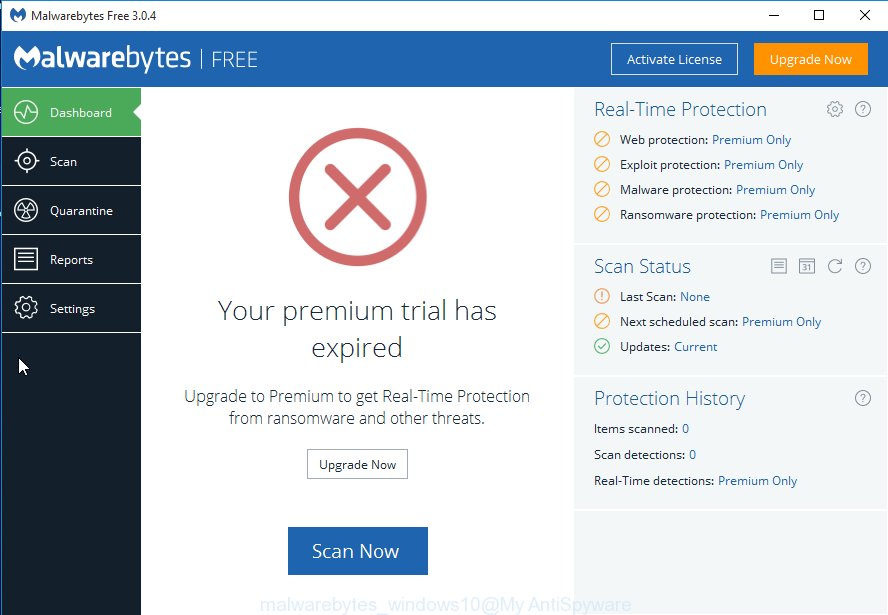
- Please download MalwareBytes Anti-Malware (MBAM) from the link below. Save it to your Desktop so that you can access the file easily.
Malwarebytes Anti-malware
327048 downloads
Author: Malwarebytes
Category: Security tools
Update: April 15, 2020
- At the download page, click on the Download button. Your browser will display the “Save as” prompt. Please save it onto your Windows desktop.
- After the downloading process is finished, please close all software and open windows on your personal computer. Double-click on the icon that’s called mb3-setup.
- This will open the “Setup wizard” of MalwareBytes Anti-Malware (MBAM) onto your system. Follow the prompts and don’t make any changes to default settings.
- When the Setup wizard has finished installing, the MalwareBytes will open and display the main window.
- Further, click the “Scan Now” button .MalwareBytes Anti Malware (MBAM) program will scan through the whole personal computer for the adware that shows misleading “Ransomware Detected” popup on your personal computer. When a threat is found, the number of the security threats will change accordingly. Wait until the the checking is finished.
- When MalwareBytes Anti Malware (MBAM) completes the scan, MalwareBytes will show a screen which contains a list of malicious software that has been detected.
- You may move threats to Quarantine (all selected by default) by simply click the “Quarantine Selected” button. When disinfection is finished, you may be prompted to restart the personal computer.
- Close the AntiMalware and continue with the next step.
Video instruction, which reveals in detail the steps above.
Scan your computer and remove “Ransomware Detected” pop-up alert with AdwCleaner
AdwCleaner is a free portable program that scans your computer for adware that created to show misleading “Ransomware Detected” popup scam within your web browser, PUPs and browser hijackers and helps remove them easily. Moreover, it’ll also help you remove any harmful web-browser extensions and add-ons.
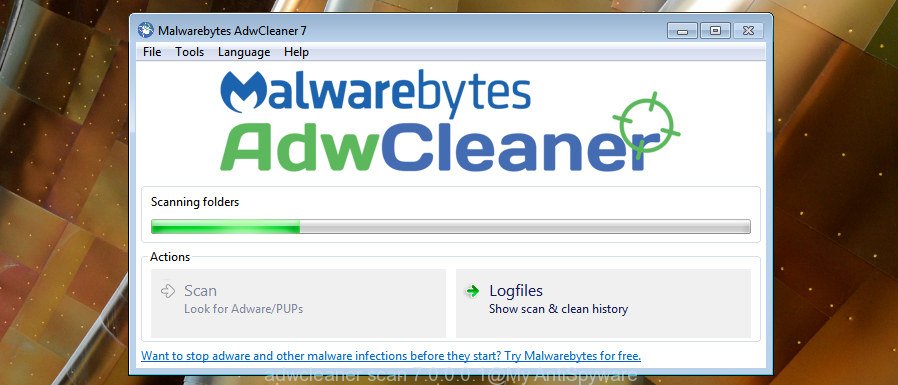
- Download AdwCleaner on your personal computer from the following link.
AdwCleaner download
225536 downloads
Version: 8.4.1
Author: Xplode, MalwareBytes
Category: Security tools
Update: October 5, 2024
- After the download is complete, double click the AdwCleaner icon. Once this utility is opened, click “Scan” button to perform a system scan with this tool for the adware that cause misleading “Ransomware Detected” popup scam to appear. A scan may take anywhere from 10 to 30 minutes, depending on the number of files on your machine and the speed of your personal computer. When a threat is found, the number of the security threats will change accordingly.
- After AdwCleaner completes the scan, AdwCleaner will show a scan report. Review the scan results and then click “Clean” button. It will show a prompt, press “OK”.
These few simple steps are shown in detail in the following video guide.
Use AdBlocker to stop “Ransomware Detected” and stay safe online
We recommend to install an ad blocking application that can block “Ransomware Detected” and other undesired web sites. The ad-blocker utility such as AdGuard is a program that basically removes advertising from the Net and blocks access to malicious web-sites. Moreover, security experts says that using ad-blocker software is necessary to stay safe when surfing the Web.
Download AdGuard program by clicking on the link below.
26840 downloads
Version: 6.4
Author: © Adguard
Category: Security tools
Update: November 15, 2018
After the downloading process is complete, launch the downloaded file. You will see the “Setup Wizard” screen as shown on the screen below.

Follow the prompts. Once the setup is complete, you will see a window like below.

You can click “Skip” to close the installation program and use the default settings, or click “Get Started” button to see an quick tutorial which will help you get to know AdGuard better.
In most cases, the default settings are enough and you do not need to change anything. Each time, when you run your computer, AdGuard will start automatically and block pop-ups, pages such “Ransomware Detected”, as well as other harmful or misleading web sites. For an overview of all the features of the program, or to change its settings you can simply double-click on the AdGuard icon, which may be found on your desktop.
Don’t know how your web-browser has been hijacked by “Ransomware Detected” popup alert?
The ad supported software gets onto PC system by being attached to some free software. So always read carefully the installation screens, disclaimers, ‘Terms of Use’ and ‘Software license’ appearing during the install procedure. Additionally pay attention for third-party applications which are being installed along with the main program. Ensure that you unchecked all of them! Also, run an ad-blocker program that will allow to stop malicious, misleading, illegitimate or untrustworthy web-sites.
Finish words
Now your machine should be free of the adware that causes multiple misleading “Ransomware Detected” alerts and popups. Delete AdwCleaner. We suggest that you keep AdGuard (to help you block unwanted advertisements and undesired harmful web sites) and Zemana (to periodically scan your machine for new adwares and other malware). Probably you are running an older version of Java or Adobe Flash Player. This can be a security risk, so download and install the latest version right now.
If you are still having problems while trying to remove “Ransomware Detected” pop-up alert from the Chrome, Mozilla Firefox, Microsoft Edge and Internet Explorer, then ask for help in our Spyware/Malware removal forum.



















